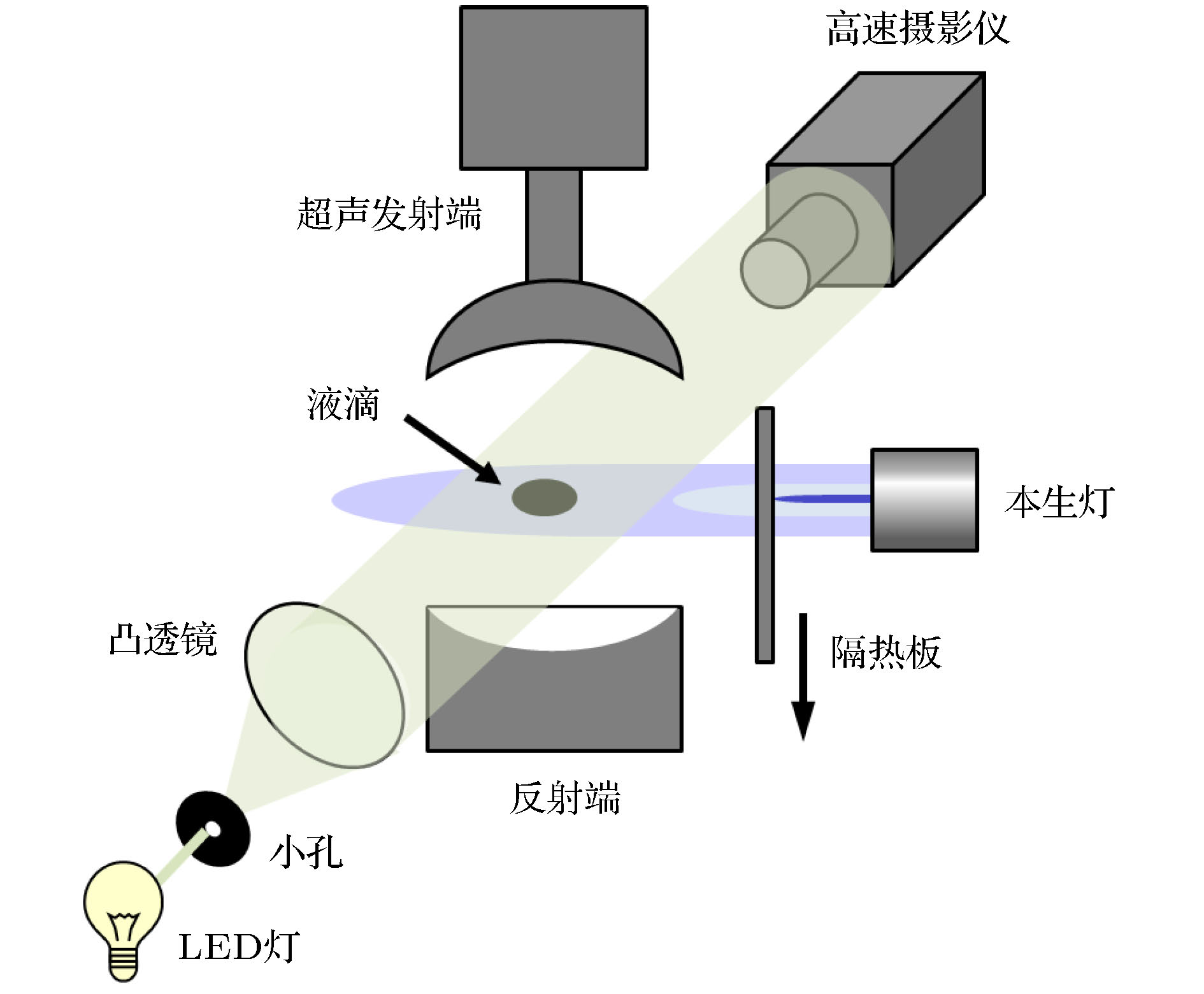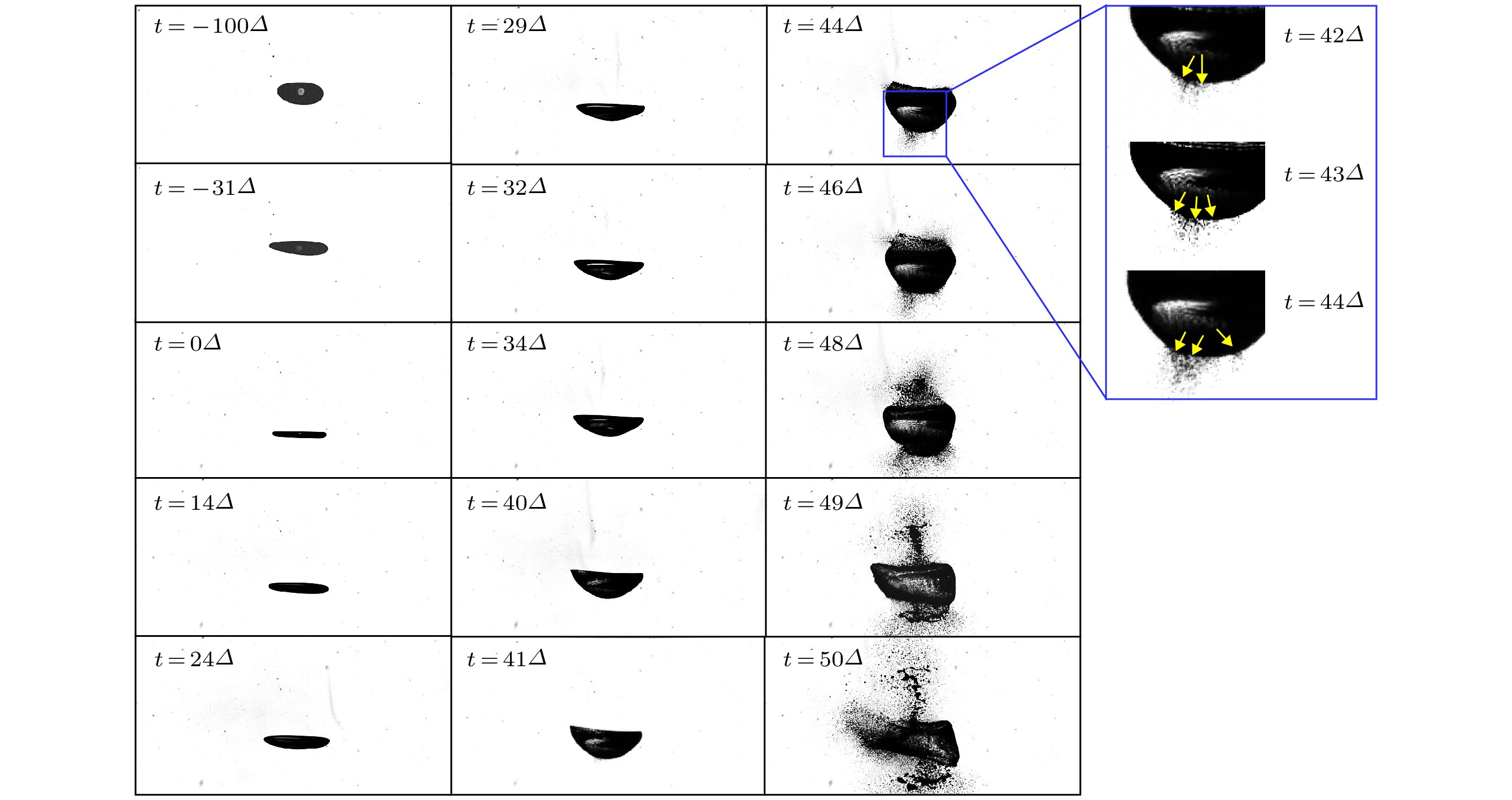-
Atomization of droplets is ubiquitous in many natural and industrial processes, such as falling rain drops, inkjet printing, fuel injection in automotive and gas-turbine engines. Acoustic irradiation provides a very effective method of atomizing fluid. However, the acoustic atomization of acoustically levitated droplet is seldom studied. To assess the possibility of achieving ultrafine atomization, we, in this paper, systematically study the atomization of an acoustically levitated droplet placed in a hot gas of a flame. High speed camera is utilized to investigate the atomization characteristics of various droplets with diameters ranging from 0.5 mm to 3.5 mm. The experimental results show that the sound pressure of the resonance acoustic field has the ability to atomize the droplet when it is suddenly bathed in hot gas. Here the heating acts as a switch to convert the droplet surface from an acoustic isolator to conductor by heating the surface to strong evaporation. The presence of a high concentration of vapor molecules surrounding the droplet caused the acoustic field to change, thus, a much larger pressure gradient is established along the droplet surface, resulting in the atomization of droplet from the equator. Furthermore, Faraday wave stimulation and discretization on the film cause the droplet to further disintegrate when the droplet diameter is large enough. The atomization consists of three different styles, i.e. rim spray (RS), film disintegration (FD) and normal sputtering (NS). When exposed to hot gas, the droplets with equivalent diameter D0 < 2.8 mm are depleted with RS until the whole mass is atomization. A thin rim is extruded at the equator and then splashed in the equator plane, the spray speed is around 9.5 m/s. Larger droplets end with the sudden FD of liquid film of the residual mass after the the RS has been consumed up. When the thickness of the rim and buckled film decrease to half of wave length, Faraday wave emerges, resulting in the vertical droplet ejection and the disintegration of the thin films. And the droplets with D0 > 3.2 mm undergo further film buckling, forming a closed bubble due to the Helmholtz resonator effect and NS at the bottom. This sound driven atomization of droplets enriches the understanding of fluid mechanism in multi-physical fields, and may provide new ideas for relative application research. -
Keywords:
- acoustic levitation /
- droplet /
- external heating /
- atomization /
- methanol
[1] Villermaux E, Bossa B 2009 Nat. Phys. 5 697
 Google Scholar
Google Scholar
[2] Minemawari H, Yamada T, Matsui H, Tsutsumi J, Haas S, Chiba R, Kumai R, Hasegawa T 2011 Nature 475 364
 Google Scholar
Google Scholar
[3] Zhang Z, Liu H F, Zhang, F, Yao M F 2016 Appl. Therm. Eng. 95 1
 Google Scholar
Google Scholar
[4] Strotos G, Malgarinos I, Nikolopoulos N, Gavaises M, Nikasd K S, Moustrisd K 2018 Int. J. Heat Fluid Flow 69 164
 Google Scholar
Google Scholar
[5] Flock A K, Guildenbecher D R, Chen J, Sojka P E, Bauer H J 2012 Int. J. Multiphase Flow 47 37
 Google Scholar
Google Scholar
[6] Khojasteh D, Kazerooni N M, Marengo M 2019 J. Ind. Eng. Chem. 71 50
 Google Scholar
Google Scholar
[7] Gad H M, Ibrahim I A, Abdelbaky A F T, Abd El-samed A K, Farag T M 2018 Exp. Therm. Fluid Sci. 99 211
 Google Scholar
Google Scholar
[8] Goodridge C L, Hentschel H G E, Lathrop D P 1999 Phys. Rev. Lett. 82 3062
 Google Scholar
Google Scholar
[9] Brandt E H 2001 Nature 413 474
 Google Scholar
Google Scholar
[10] Yarin A L, Brenn G, Kastner O, Rensink D, Tropea C 1999 J. Fluid Mech. 399 151
 Google Scholar
Google Scholar
[11] Yarin A L, Pfaffenlehner M, Tropea C 1998 J. Fluid Mech. 356 65
 Google Scholar
Google Scholar
[12] Xie W J, Wei B 2001 Appl. Phys. Lett. 79 881
 Google Scholar
Google Scholar
[13] 杜人君, 解文军 2011 60 114302
 Google Scholar
Google Scholar
Du R J, Xie W J 2011 Acta Phys. Sin. 60 114302
 Google Scholar
Google Scholar
[14] Kooij S, Astefanei A, Corthals G L, Bonn D 2019 Sci. Rep. 9 6128
 Google Scholar
Google Scholar
[15] Friend J, Yeo L 2012 J. Acoust. Soc. Am. 131 3303
[16] Basu S, Saha A, Kumar R 2012 Appl. Phys. Lett. 100 054101
 Google Scholar
Google Scholar
[17] Pathak B, Basu S 2016 Phys. Fluids 28 123302
 Google Scholar
Google Scholar
[18] Zang D Y, Li L, Di W L, Zhang Z H, Ding C L, Chen C, Shen W, Binks B P, Geng X G 2018 Nat. Commun. 9 3546
 Google Scholar
Google Scholar
[19] Kinsler L E, Frey A R, Coppens H B 1983 Fundamentals of Acoustics (3rd Ed.) (New York: Wiley) pp233–259
[20] Opstal J V 2016 The Auditory System and Human Sound-Localization Behavior (Amsterdam: Elsevier) pp23–50
[21] Fu T, Mao Y J, Tang Y, Zhang Y W, Yuan W 2015 Nanoscale Microscale Thermophys. Eng. 19 17
 Google Scholar
Google Scholar
[22] Kudrolli A, Gollub J P 1996 Phys. Rev. E 54 1052
 Google Scholar
Google Scholar
[23] Donnelly T D, Hogan J, Mugler A, Schommer N, Schubmehl M, Bernoff A J, Forrest B 2004 Phys. Fluids 16 2843
 Google Scholar
Google Scholar
[24] Kelvin L, Thompson W 1871 Philos. Mag. 42 362
 Google Scholar
Google Scholar
[25] Rayleigh L 1883 Philos. Mag. 16 50
 Google Scholar
Google Scholar
[26] Cheng H, Zhao J Y, Wang J 2019 Int. J. Heat Mass Transfer 132 388
 Google Scholar
Google Scholar
[27] Ding C L, Chen H J, Zhai S L, Liu S, Zhao X P 2015 J. Phys. D 48 045303
 Google Scholar
Google Scholar
-
图 3 甲醇液滴溅射时的参数描述 (a) 扩散直径; (b) 无量纲液核直径; (c) 赤道处曲率半径; (d) 气液界面在室温和强蒸发时的液体与空气分子分布[21]
Figure 3. Parametrical description of the breaking process: (a) Spreading diameter Ds; (b) the dimensionless diameter Dc of liquid core; (c) equatorial curvature radii Rcav vs. time; (d) liquid and air molecule distribution at the interface at ambient temperature and strong evaporation conditions[21].
-
[1] Villermaux E, Bossa B 2009 Nat. Phys. 5 697
 Google Scholar
Google Scholar
[2] Minemawari H, Yamada T, Matsui H, Tsutsumi J, Haas S, Chiba R, Kumai R, Hasegawa T 2011 Nature 475 364
 Google Scholar
Google Scholar
[3] Zhang Z, Liu H F, Zhang, F, Yao M F 2016 Appl. Therm. Eng. 95 1
 Google Scholar
Google Scholar
[4] Strotos G, Malgarinos I, Nikolopoulos N, Gavaises M, Nikasd K S, Moustrisd K 2018 Int. J. Heat Fluid Flow 69 164
 Google Scholar
Google Scholar
[5] Flock A K, Guildenbecher D R, Chen J, Sojka P E, Bauer H J 2012 Int. J. Multiphase Flow 47 37
 Google Scholar
Google Scholar
[6] Khojasteh D, Kazerooni N M, Marengo M 2019 J. Ind. Eng. Chem. 71 50
 Google Scholar
Google Scholar
[7] Gad H M, Ibrahim I A, Abdelbaky A F T, Abd El-samed A K, Farag T M 2018 Exp. Therm. Fluid Sci. 99 211
 Google Scholar
Google Scholar
[8] Goodridge C L, Hentschel H G E, Lathrop D P 1999 Phys. Rev. Lett. 82 3062
 Google Scholar
Google Scholar
[9] Brandt E H 2001 Nature 413 474
 Google Scholar
Google Scholar
[10] Yarin A L, Brenn G, Kastner O, Rensink D, Tropea C 1999 J. Fluid Mech. 399 151
 Google Scholar
Google Scholar
[11] Yarin A L, Pfaffenlehner M, Tropea C 1998 J. Fluid Mech. 356 65
 Google Scholar
Google Scholar
[12] Xie W J, Wei B 2001 Appl. Phys. Lett. 79 881
 Google Scholar
Google Scholar
[13] 杜人君, 解文军 2011 60 114302
 Google Scholar
Google Scholar
Du R J, Xie W J 2011 Acta Phys. Sin. 60 114302
 Google Scholar
Google Scholar
[14] Kooij S, Astefanei A, Corthals G L, Bonn D 2019 Sci. Rep. 9 6128
 Google Scholar
Google Scholar
[15] Friend J, Yeo L 2012 J. Acoust. Soc. Am. 131 3303
[16] Basu S, Saha A, Kumar R 2012 Appl. Phys. Lett. 100 054101
 Google Scholar
Google Scholar
[17] Pathak B, Basu S 2016 Phys. Fluids 28 123302
 Google Scholar
Google Scholar
[18] Zang D Y, Li L, Di W L, Zhang Z H, Ding C L, Chen C, Shen W, Binks B P, Geng X G 2018 Nat. Commun. 9 3546
 Google Scholar
Google Scholar
[19] Kinsler L E, Frey A R, Coppens H B 1983 Fundamentals of Acoustics (3rd Ed.) (New York: Wiley) pp233–259
[20] Opstal J V 2016 The Auditory System and Human Sound-Localization Behavior (Amsterdam: Elsevier) pp23–50
[21] Fu T, Mao Y J, Tang Y, Zhang Y W, Yuan W 2015 Nanoscale Microscale Thermophys. Eng. 19 17
 Google Scholar
Google Scholar
[22] Kudrolli A, Gollub J P 1996 Phys. Rev. E 54 1052
 Google Scholar
Google Scholar
[23] Donnelly T D, Hogan J, Mugler A, Schommer N, Schubmehl M, Bernoff A J, Forrest B 2004 Phys. Fluids 16 2843
 Google Scholar
Google Scholar
[24] Kelvin L, Thompson W 1871 Philos. Mag. 42 362
 Google Scholar
Google Scholar
[25] Rayleigh L 1883 Philos. Mag. 16 50
 Google Scholar
Google Scholar
[26] Cheng H, Zhao J Y, Wang J 2019 Int. J. Heat Mass Transfer 132 388
 Google Scholar
Google Scholar
[27] Ding C L, Chen H J, Zhai S L, Liu S, Zhao X P 2015 J. Phys. D 48 045303
 Google Scholar
Google Scholar
Catalog
Metrics
- Abstract views: 11317
- PDF Downloads: 141
- Cited By: 0















 DownLoad:
DownLoad:






